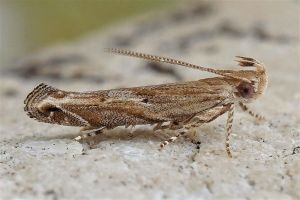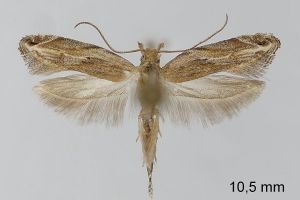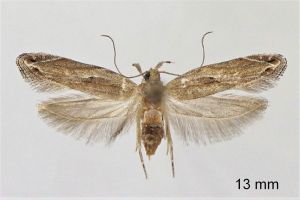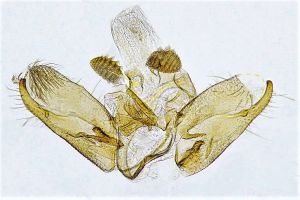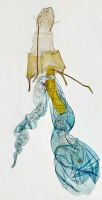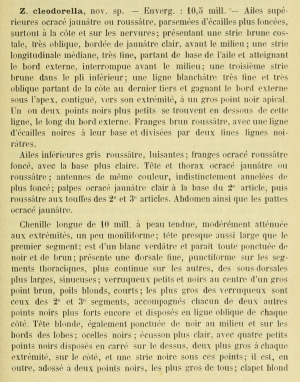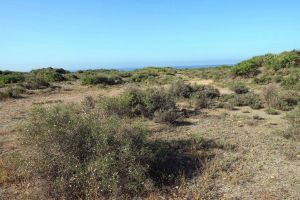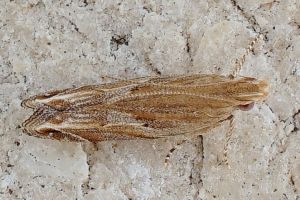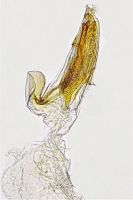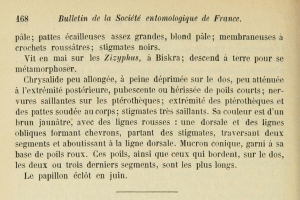

 +3Kontinente:EUAF
+3Kontinente:EUAF1. Lebendfotos
1.1. Falter
2. Diagnose
2.1. Männchen
2.2. Weibchen
2.3. Genitalien
2.3.1. Männchen
2.3.2. Weibchen
2.4. Erstbeschreibung
3. Biologie
3.1. Habitat
3.2. Nahrung der Raupe
- [Rhamnaceae:] Zizyphus sp.
- [Rhamnaceae:] Zizyphus mauritiana ?
Chrétien (1908: 167-168) lieferte eine ausführliche Beschreibung der Raupe, fasste sich bei der Biologie aber kurz: "Vit en mai sur les Zizyphus, à Biskra; descend à terre pour se métamorphoser." Die Raupen waren im Mai offensichtlich ausgewachsen, denn der Falter schlüpfte im Juni.
Kaila et al. (2024: 22) kannten die Raupe nicht selbst, konnten also nur wiederholen: "The larva and pupa were described in detail in the original description (Chrétien, 1908), but the life history was only briefly summarized. The larva feeds during May on Ziziphus (probably Z. mauritiana Lam. or Z. lotus Lam.) (Rhamnaceae), afterwards descending to the ground to pupate. The adults emerge in June (Chrétien 1908) and October. Mück (1985: 20, 163) lists Z. cleodorella from Ziziphus mauritiana in the Cape Verde Islands, without a detailed locality, but it is unclear if this was based on personal observation."
Bei der Beschreibung des Habitats in Spanien wird es aber interessant (S. 22-23): "The biotope where this species occurs in Spain is a sandy area with narrow, mobile dunes (Fig. 7), within the semi-arid thermo-Mediterranean climatic zone with high atmospheric humidity, where extensive formations of Ziziphus lotus (“azufaifo” in Spanish) occur, together with patches of annual grassland. Tamarix sp., Ephedra sp., Ononis sp., Thymelaea sp. etc. complete the markedly African botanical character of this landscape, distinctive of the Retamar area where Z. cleodorella occurs." Es ist also extrem wahrscheinlich, dass die Raupe in Südspanien an Ziziphus lotus (Wilde Jujube) lebt.
Mück (1985: 163) listete "Zizyphia cleodorella Chretien: Zizyphus mauritiana Lam." in seinem "Anhang 1: Systematisches Verzeichnis der Schadlepi[d]opteren und ihrer Futterpflanzen auf den Kapverden". In seiner Arbeit nennt er aber keine konkrete Angabe, so dass Fragen offen bleiben.
(Autor: Erwin Rennwald)
4. Weitere Informationen
4.1. Taxonomie
Die Gattung Zizyphia wurde klassischerweise zu den Gelechiidae, Gelechiinae gerechnet, konnte dort aber keiner Tribus zugeordnet werden, weshalb wir sie im Lepiforum ans Ende der Gelechiinae stellten. In neuerer Zeit gab es aber auch Vorschläge, sie zu den Orophiini und mit diesen zu den Oecophoridae zu stellen, oder auch zu den Depressariidae. Lvovsky (2009) vertrat letzteres und fasst in seinem englischen Abstract zusammen: "The genus Zizyphia hitherto considered in the family Gelechiidae (Lepidoptera) is placed into the family Depressariidae (tribe Orophiini). This conclusion is substantiated by the peculiarities of the shape and venation of the wings, and the structure of the male genitalia studied in this genus for the first time." Auch im russischen Text wird die Neuzuordnung fast vollständig mit Details der Genitalien begründet.
Lvovsky et al. (2016) werteten die Cryptolechiidae als eigene Familie und stellten die Gattung Zizyphia jetzt hierher.
Kaila et al. (2024: 20-21) schließlich stellen die Gattung in die Unterfamilie Cacochroinae der Depressariidae: "We consider the genus Zizyphia to belong to Cacochroinae (Depressariidae) (see Discussion on systematics and nomenclature below). Members of Cacochroinae share the usual characteristics of Gelechioidea, i.e. the basally-scaled haustellum and long, upcurved labial palpi, the second segment of which is particularly long. They are relatively small and slender winged compared to most Depressariidae. [...] The male genitalia of Cacochroa permixtella (Herrich-Schäffer, 1854) are anomalous, compared to virtually all other species of Gelechioidea, in having an enormous-sized vinculum (cf. Corley and Ferreira 2019). The female genitalia are rather similar to that of Zizyphia, but the signum is more similar to that of Rosetea. Along with Rosetea, it also differs from others in not having a gnathos. It should be noted that the structure called the uncus by Corley and Ferreira (2019) for C. permixtella is actually the anellus that surrounds the phallus. The true uncus is vestigial and weakly sclerotized, situated dorsad of the more distinctive tuba analis. Even though C. permixtella has such distinctive features, it also shares characters with Rosetea, including the vestigial uncus and well-developed tuba analis, and divided valva, in addition to a markedly similar outer appearance. It also has broadly separated valvae that are typical of other genera. Therefore, we consider C. permixtella a close relative of other genera treated here. However, discussion of the status or species composition of the established cacochroine genera is beyond the scope of this publication."
4.2. Faunistik
Chrétien (1908: 167-168) beschrieb die Art aus Biskra in Algerien. Mück (1985: 163) listete sie in seinem "Anhang 1: Systematisches Verzeichnis der Schadlepi[d]opteren und ihrer Futterpflanzen auf den Kapverden". Und Kaila et al. (2024: 22) überraschten mit gleich mehreren Nachweisen in wüstenartigen Bereichen Südspaniens - und damit erstmals in Europa: "Examined material. Spain, prov. Almeria, Sierra Alhamilla, 400 m, 1♀ 3/4.x.2022, leg. Tx. Revilla (TxR); prov. Almeria, Retamar, 25 m, 1♀ 3/4.x.2022, leg. Tx. Revilla (TxR); same locality but 15 m, 3♂, 4/5.x.2022, 4♂, 2♀, 16.x.2022, P. Skou leg. (MZH, ZMUC)."
(Autor: Erwin Rennwald)
4.3. Literatur
- Erstbeschreibung: Chrétien, P. (1908): Description de Microlépidoptères nouveaux d'Algérie. — Bulletin de la Société entomologique de France 1908: 165-168. Paris. [Digitalisat auf biodiversitylibrary.org]
- Kaila, L., Karsholt, O. & T. Revilla (2024): The genus Zizyphia Chrétien, 1908, with notes on its systematic position and the first record of Z. cleodorella Chrétien, 1908 from Europe (Lepidoptera, Depressariidae, Cacochroinae). — Nota Lepidopterologica, 47: 19-28. [zur Arbeit mit PDF-Download auf nl.pensoft.net]
- Mück, O. (1985): Biologie, Verhalten und wirtschaftlische Bedeutung von Parasiten schädlicher Lepidopteren aus den Kapverden. - Neue entomologische Nachrichten 18: 1–168. [pls 1–3]. [PDF auf zobodat.at]




